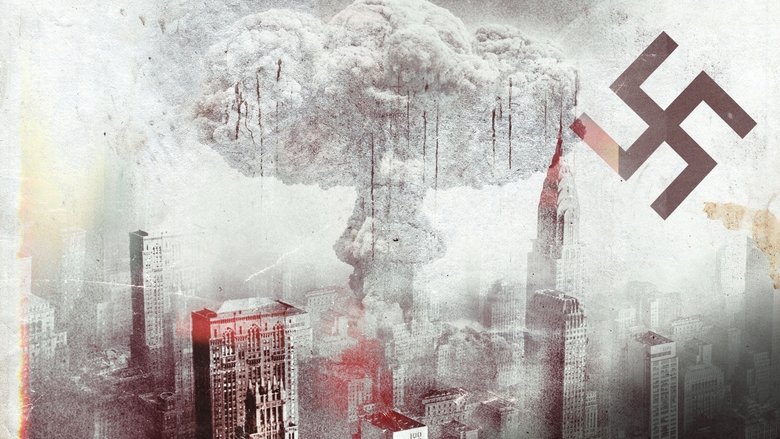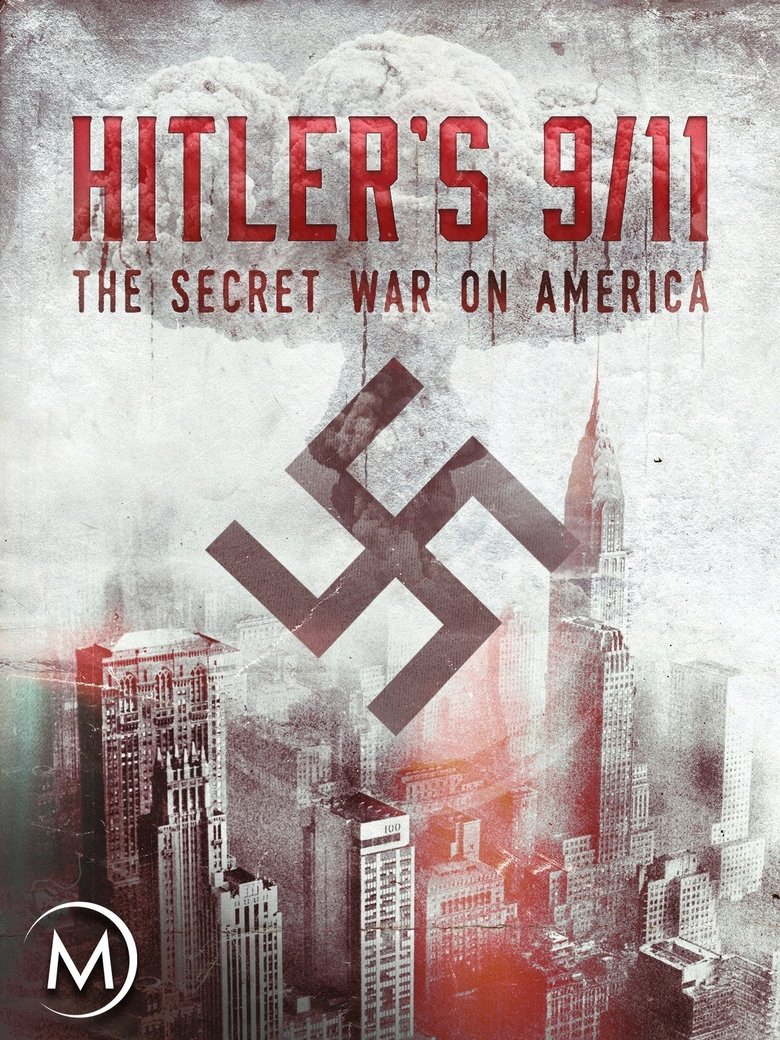Loading


Hitler's 9/11
Genres
DocumentaryTV Movie
Overview
Adolf Hitler's Nazi megalomania knew no limits. The most daring of his plans World War II involved German fighter planes crashing into Manhattan's skyscrapers as living bombs, like the Japanese kamikazes. Hitler understood the huge symbolic power of Manhattan's skyscrapers. He believed suicide bombing would have a devastating psychological impact on the American people and the U.S. war effort.
Details
Budget
$0
Revenue
$0
Runtime
51 min
Release Date
2013-01-01
Status
Released
Original Language
English
Vote Count
0
Vote Average
0
Cast
Meet the talented actors who bring the movie to life.
Wilhelm Canaris
Self (archive footage)
Adolf Hitler
Self (archive footage)
Similar Movies
Explore movies similar to this one that you might also enjoy.
0.0
De Bevrijding van Den Haag
2010-01-01 | nl
6.0
The Good War and Those Who Refused to Fight It
A documentary focusing on American conscientious objectors during WWII.
2002-01-13 | en
0.0
The Reckoning: Remembering the Dutch Resistance
Documentary - The Reckoning: Remembering the Dutch Resistance is the international award-winning documentary that captures the compelling story and eyewitness account of six survivors in war-torn Netherlands during World War II. - Diet Eman
2007-01-01 | en
5.0
Safeguarding Military Information
World War II propaganda short which focuses on the dangers of inadvertent dispersal of military information.
1942-01-16 | en
9.0
Britain's Greatest Pilot: The Extraordinary Story of Captain Winkle Brown
Captain Eric 'Winkle' Brown recounts his flying experiences, encounters with the Nazis and other adventures leading up to and during the Second World War. Illustrated with archive footage and Captain Brown's own photos.
2014-06-01 | en
6.4
A Woman Deceived
It’s been one year since Elizabeth’s husband, Bill, died in a tragic horseback riding accident and she is starting to move on. When she runs into Travis Brown, the cowboy she met the same weekend Bill died, the two immediately hit it off. Travis is just what Elizabeth needed to come into her life and they soon get married. When new evidence surfaces implying that Bill’s death wasn’t an accident, Elizabeth must find a way to protect herself and her son from the man she married.
2017-05-18 | en
7.0
Auschwitz: Countdown To Liberation
2025-01-26 | en
10.0
Cartoons Go To War
This remarkable documentary dedicates itself to an extraordinary chapter of the second World War – the psychological warfare of the USA. America’s trusted cartoon darlings from the studios of Warner Bros., Paramount, and the “big animals” of the Disney family were supposed to give courage to the people at the homefront, to educate them, but also to simultaneously entertain them. Out of this mixture grew a genre of its own kind – political cartoons. Insightful Interviews with the animators and producers from back then elucidate in an amusing and astonishing way under which bizarre circumstances these films partially came into existence.
1996-04-26 | en
0.0
The Architects of Hope: The First Steps in Rebuilding Ukraine
This feature documentary follow 5 architects on their determined journeys to continue building during wartime, as they seek a new people-focused identity for Ukrainian architecture. While Russia continues to turn former Ukrainian cities to dust, Ukraine’s leading architects are already building upwards & advanced new buildings are rising again as symbols of hope.
2024-02-24 | en
7.0
School for Danger
Britain's Special Operations Executive (SOE) provides trained agents, arms and other assistance to the European resistance groups fighting against Hitler. British agents, Captain Harry Rée DSO, OBE, Croix De Guerre, Médaille de la Résistance, aka "Felix", and Jacqueline Nearne, MBE, aka "Cat", recreate some of their adventures in France.
1947-06-02 | en
1.0
Shameless Propaganda
This feature documentary examines its own genre, which has often been called Canada's national art form. Released in the year of the NFB's 75th birthday, Shameless Propaganda is filmmaker Robert Lower's take on the boldest and most compelling propaganda effort in our history (1939-1945), in which founding NFB Commissioner John Grierson saw the documentary as a "hammer to shape society". All 500 of the films produced by the NFB until 1945 are distilled here for the essence of their message to Canadians. Using only these films and still photos from that era, Lower recreates the picture of Canada they gave us and looks in it for the Canada we know today. What he finds is by turns enlightening, entertaining, and unexpectedly disturbing.
2013-07-01 | en
8.0
June 1940, the Great Chaos
From May 10, 1940, France is living one of the worst tragedies of it history. In a few weeks, the country folds, and then collapsed in facing the attack of the Nazi Germany. On June 1940, each day is a tragedy. For the first time, thanks to historic revelations, and to numerous never seen before images and documents and reenacted situations of the time, this film recounts the incredible stories of those men and women trapped in the torment of this great chaos.
2010-06-14 | fr
6.0
The Liberation of Paris
French Resistance's documentary during the liberation of Paris in August 1944.
1944-08-26 | fr
0.0
Elie Wiesel Goes Home
A documentary chronicling the adolescent years of Elie Wiesel and the history of his sufferings. Eliezer was fifteen when Fascism brutally altered his life forever. Fifty years later, he returns to Sighetu Marmatiei, the town where he was born, to walk the painful road of remembrance - but is it possible to speak of the unspeakable? Or does Auschwitz lie beyond the capacity of any human language - the place where words and stories run out?
1997-02-12 | hu
0.0
The Men Who Brought the Dawn
1995-06-01 | en
6.9
Shine a Light
Martin Scorsese’s electrifying concert documentary captures The Rolling Stones live at New York’s Beacon Theatre during their A Bigger Bang tour. Filmed over two nights in 2006 with an all-star team of cinematographers, the film combines dynamic performances with archival footage and rare glimpses behind the scenes, offering a vibrant portrait of the band’s enduring energy and legacy.
2008-04-04 | en
0.0
Wealth of a Nation
"This film explores how freedom of speech — including dissent — is afforded to all Americans, and shows freedom of expression in art, music, dance, architecture, and science. The film also emphasizes the importance of the individual’s contribution to the whole of society and demonstrates how a productive and creative society is formed by the open and respectful exchange of ideas. The film was written, produced, and directed by William Greaves" (National Archives).
1964-01-01 | en
0.0
Never Again: The United States Holocaust Memorial Museum - A Tour with Wolf Blitzer
The child of Holocaust survivors, CNN Anchor Wolf Blitzer, takes viewers through the United States Holocaust Memorial Museum and beyond, connecting the hours of the Holocaust and their modern parallels and his family story.
2022-08-26 | en
0.0
Paint Until Dawn: a documentary on art in the life of James Gahagan
Seeing is to painting what listening is to politics. Survival as an artist demands both. Paint Until Dawn is a documentary on art in the life of James Gahagan (1927-1999), who painted all night to push the limits of vision. His life and thought reveal a correlation between art and activism through an interesting angle: the creative process itself.
2020-06-08 | en
0.0
Grandmother Told Grandmother
The little-known story of Ukrainian children torn from their homes in the crush between the Nazi and Soviet fronts in World War II. Spending their childhood as refugees in Europe, these inspiring individuals later immigrated to the United States, creating new homes and communities through their grit, faith and deep belief in the importance of preserving culture.
2018-10-07 | en